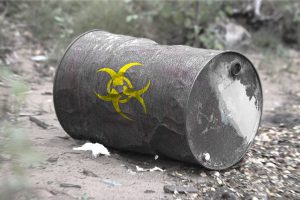- December 3, 2017
- Posted by: David Marshall
- Category: Management, Safety

Manufacturers who contaminate, pollute, and commit environmental infractions as part of their manufacturing process aren’t only risking a guilty conscience or the shouts and disparagement of environmental activists. If your manufacturing company is found to be committing environmental infractions, you run the risk of being sent to jail as well.
For years, I worked closely with Laura Rectenwald of Titanium Environmental who handled the environmental issues in every one of my operations. She provided professional guidance, training, and oversight to each one of our operating groups. And thanks to her work, I was very aware of what we faced as a company, given the different products we used and byproducts we made. Those had to be disposed of properly, or else my executive team and I faced some serious problems.
The last time I checked, there are a number of CEOs doing 300 years in prison for environmental infractions. The City of Flint, Michigan will no doubt see more than a few people heading there as well. Not just for lying to investigators, but because what they did can be deemed as gross negligence. So those infractions will have both a civil and a criminal penalty involved.
This is why your executives and staff should be fully engaged and educated, and why you need to work with environmental experts who can provide that education because the regulations are absolutely unforgiving.
 For example, one regulation says that you have to sample and record water that runs off your property during a rain event to ensure there are no contaminants in it. The recording of it is important because at any point in time, the state or federal EPA can audit your records. And if they don’t see a recording that matches when the historic meteorological records say there was a rain event, you’re in for a heap of trouble.
For example, one regulation says that you have to sample and record water that runs off your property during a rain event to ensure there are no contaminants in it. The recording of it is important because at any point in time, the state or federal EPA can audit your records. And if they don’t see a recording that matches when the historic meteorological records say there was a rain event, you’re in for a heap of trouble.
The thinking is that if you’ve got any contaminants that show up during a rain event, that means contaminants in your plant are washing away during the rain and getting into the local water supply.
So you need to ensure that every container in your facility that has a liquid in it is properly labeled stating what that liquid is. You must also have a corresponding MSDS sheet (Material Safety Data Sheet) so if someone spills the liquid, you can clean it up and dispose of it in the right way.
In manufacturing, you’ll almost always have solvents to use in the manufacturing process. None of these are considered safe, and so there has to be a very tight control of them and a method of monitoring them. Otherwise, if these contaminants run off into the sewer and end up in your local wastewater treatment system, it can lead back to you. And getting a knock on your door from your local EPA agent saying you’ve probably contaminated the water system is not something you want to deal with. If you’re lucky, you’ll only face a stiff fine. If you’re unlucky, you’ll face jail time as well.
This is why I preach monitoring and measuring as much as possible. While a lot of the monitoring and measuring may be required by the state and federal EPA, it also helps you if there are ever any questions or doubts about whether you’ve done everything you’re supposed to in preventing environmental infractions. If you’ve got plenty of data to back you up and show that you’ve been compliant and well within the scope of acceptable specs, you can protect yourself and your company.
I’ve been a manufacturing executive, as well as a sales and marketing professional, for a few decades. Now I help companies turn around their own business, including reducing environmental infractions. If you would like more information, please visit my website and connect with me on Twitter or LinkedIn.
Photo credit: NeuPaddy (Pixabay, Creative Commons 0, Public Domain)

